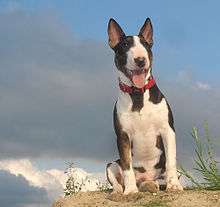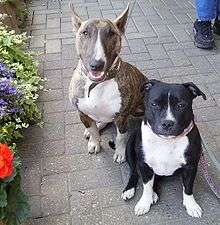Bull Terrier (Miniature)
 Standard (left) and Miniature Bull Terriers | ||||||||||||||||||||||||||
| Other names | Miniature Bull Terrier | |||||||||||||||||||||||||
|---|---|---|---|---|---|---|---|---|---|---|---|---|---|---|---|---|---|---|---|---|---|---|---|---|---|---|
| Origin | England | |||||||||||||||||||||||||
| ||||||||||||||||||||||||||
| ||||||||||||||||||||||||||
| Domestic dog (Canis lupus familiaris) | ||||||||||||||||||||||||||
The Bull Terrier (Miniature) is a breed with origins in the extinct English White Terrier, the Dalmatian and the Bulldog. The first existence is documented 1872 in The Dogs of British Island.
Description
Appearance


Miniature Bull Terriers have short, fine, and glossy coats that are very close to the skin, like the Bull Terriers. They are accepted in the ring to be white, white with another colour, or fully coloured. However, like the Standards, any blue or liver coloured coats are undesirable. These dogs require minimal grooming.
In the early 1900s, the difference between the breeds was determined by the dog's weight. However, this led to Miniature Bull Terriers becoming so small and fine that they looked more like a Chihuahua than a Bull Terrier. So, in the 1970s, the weight limit was replaced with a height limit of under fourteen inches. They are usually no smaller than ten inches. According to the AKC, miniature bull terriers' weight must be proportionate to its height. However, they tend to range anywhere from 20–35 lbs.
The Miniature Bull Terriers have a very bold build. They have very muscular shoulders and a full body. Like the Bull Terrier, they have a head described as "egg-shaped." It is flat on top with a Roman nose. The eyes are triangular and closely set. The ears are carried erect and are not cropped or otherwise altered.The tail is carried horizontally rather than vertically.
Temperament
Like the Bull Terriers, Minis are loving and, like many terrier breeds, they can be stubborn at times; but despite this they make great dogs for people with limited space.
Miniature Bull Terriers are known to be stubborn and courageous. They do not seem to realize their size, however, because even if confronting an enormous dog they will not back down. However, with the right training, confrontations can be avoided. They are very energetic and playful. They love people but care must be taken as they are variable around other dogs.
Care
As mentioned before, Miniature Bull Terriers require little grooming. A quick brushing once a day or a few times a week is sufficient to keep the fur in order, as it cannot become tangled due to its length. Sunscreen must be used on any sparse white sections of fur around the face, ears, hindquarters or stomach when outdoors (especially in the summer between the hours of 10am and 2pm) to avoid sunburn and cancer.
Training
Miniatures are independent and stubborn and do require a lot of training, particularly early on. They must be heavily socialized at a young age and trained to obey early in their lives. They also are very energetic and seem to be able to play endlessly as puppies. However, as they grow older, they become less energetic. They must be carefully exercised and dieted to avoid obesity.
Health
Miniature Bull Terriers are generally quite healthy, but there are hearing, eye, skin, kidney, heart and knee problems in some dogs. Deafness occurs in both coloured and white Bull Terrier (Miniature). Puppies can be born unilaterally deaf (deaf in one ear) or bilaterally deaf (deaf in both ears). Deaf dogs should not be bred due to deafness being hereditary.[1] BEAP (or BAER) testing is done on puppies prior to sale to discover which puppies have hearing problems.
Bull Terrier (Miniature) are also susceptible to having luxating patellas. This is a knee problem common in small dogs. It can be treated by surgery.
Polycystic kidney disease (PKD) and Bull Terrier hereditary nephritis (BTHN) are autosomal dominant diseases. PKD is diagnosed by Ultrasonic scan by a specialist veterinarian. BTHN is diagnosed by a UPC test. Dogs with a score of .3 or below are considered clear of the disease. Clearing breeding stock prior to use ensures that progeny are not affected with the disease.
Miniature Bull Terriers are also susceptible to eye problems such as primary lens luxation. PLL is a late onset disease which typically affects dogs between the ages of mid 2 and 7. Younger and older cases are known. During September 2009 a definitive DNA test was released by the Animal Health Trust. This test gives three results: Clear, Carrier, or Affected.
Aortic valve stenosis and mitral valve dysplasia are heart diseases. Diagnosis is made by colour doppler echocardiography scanning by a specialist veterinarian.
Disorders of the skin of a Miniature Bull Terrier can occur. Pyotraumatic dermatitis (hot spots), allergic reactions, and hives can be problematic. UK and US breed surveys shows an average lifespan of 10-14 years.[2]
History
When the Standard breed was first created in 19th century England, it was about the same size as Miniature Bull Terriers.[3] Miniature Bull Terriers were granted membership in the American Kennel Club (AKC) on May 14, 1991 (effective January 1, 1992).[4][5]
Interbreeding
Interbreeding, the process of mating together a Bull Terrier (Miniature) and Bull Terrier, is allowed, only for a short time, in Australia, New Zealand, and the United Kingdom. Interbreeding is undertaken to reduce the incidence of Primary Lens Luxation in the Miniature. The Bull Terrier does not carry the PLL gene so all progeny are phenotypically normal for the disease.
See also
References
- ↑ "Bull Terrier Health: Deafness". Bull Terriers Health UK. Retrieved 2008-04-13.
- ↑ "Breed Longevity Data".
- ↑ "Miniature Bull Terrier History". American Kennel Club. Retrieved 2008-04-13.
- ↑ "Miniature Bull Terrier Breed Standard". American Kennel Club. Retrieved 2008-04-13.
- ↑ "Miniature Bull Terrier (coloured)". Dog.com. Retrieved 2008-04-13.